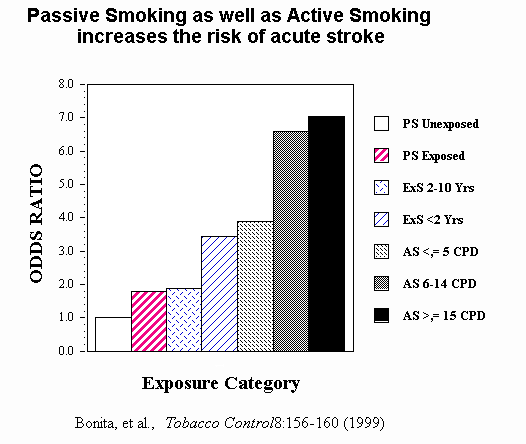 |
Home |
Fact Sheet on Secondhand Smoke (cont.) |
| James. Repace, MSc., Physicist
Ichiro Kawachi, PhD, Associate Professor Stanton Glantz, PhD., Professor 9/1/99 |
 |
Home |
Fact Sheet on Secondhand Smoke (cont.) |
| James. Repace, MSc., Physicist
Ichiro Kawachi, PhD, Associate Professor Stanton Glantz, PhD., Professor 9/1/99 |
Law et al. (1997) review the evidence from 19 published studies of passive smoking and heart disease; they report that the average excess risk of ischemic heart disease from passive smoking epidemiological studies is 23% (95% CI:14% to 33%), and conclude that platelet aggregation provides a plausible explanation for the mechanism and magnitude of the effect.
Kawachi, et al. (1997) in a prospective study of coronary heart disease (CHD) in 32,000 female U.S. nurses aged 31 to 61 yr., for nonsmoking women exposed only at work, observed a dose-response gradient for passive smoking and CHD. Adjusted relative risks of CHD were 1.00 [for no exposure], 1.58 (95% CI, 0.93-2.68) [occasional exposure], and 1.91 (95% CI, 1.11-3.28) [regular exposure]. Thus, regular exposure to SHS at work caused a 91% increase in CHD, shown in Figure 3 below.

Tunstall-Pedoe et al. (1995), in a Scottish cross-sectional study of passive smoking and heart disease in 786 men and 1492 women, found that increasing quantitative measures of serum cotinine in ng/ml correlated to physician-diagnosed heart disease risk, with an odds ratio of 2.7 (95% CI, 1.3-5.6) for the highest vs. the lowest exposure quartile, adjusted for age, housing tenure, total cholesterol, and blood pressure. This is illustrated below in Figure 4.

Figure 4. Risk of physician-diagnosed coronary heart disease in nonsmokers as a function of the level of the nicotine metabolite, cotinine in blood serum, in units of nanograms per milliliter (ng/ml). This is further powerful evidence that SHS exposures are not "low" as the tobacco industry asserts.
Figure 4A below shows the strong dose-response between tobacco smoke exposure and risk of acute stroke in New Zealand (Bonita, et al., 1999).

The most recent comprehensive report on secondhand smoke (referred in the report as environmental tobacco smoke or ETS) in the U.S. is that issued by the California Environmental Protection Agency in 1997. The California EPA report concluded that SHS was a cause of cancer, heart disease, and respiratory disease. The major conclusions of the CalEPA Report (Tables ES.1 and ES.2) are reproduced in Figures 5 - 7 below.

The most recent report on SHS from the UK, the SCOTH Report (1998), also concluded that passive smoking is a cause of lung cancer and childhood respiratory disease, and that passive smoking is a cause of ischaemic heart disease and cot death (SIDS), middle ear disease and asthmatic attacks in children. The SCOTH report concludes that restrictions on smoking in public places and work places are necessary to protect non smokers (SCOTH, 1998).

In addition to the above, Wells (1998) recently reported that there are now four studies each, which suggest an increased breast cancer risk from both passive smoking (combined OR for never-smokers: 1.71 (95% CI 1.30-2.25), and active smoking (combined OR 2.17 (95% CI 1.63-2.88), respectively.

Table 1, adapted from the California EPA Report (CalEPA, 1997) gives the State’s estimates of passive smoking-induced disease morbidity and mortality for the U.S.A., and per 10 million population, assuming that the nonsmoking population is similar in exposure and age to the U.S.A., for purposes of estimation in other countries.
Condition |
Number of People or Cases | |
| In the U.S.A. | per 10 million pop. | |
| Developmental Effect Low Birthweight |
9,700 to 18,600 cases | 360 to 690 cases |
| Sudden Infant Death Syndrome (SIDS) | 1900 to 2700 deaths | 70 to 100 deaths |
| Respiratory Effects in Children | ||
| Middle Ear Infection | 0.7 to 1.6 million physician office visits |
26,000 to 59,000 physician office visits |
| Asthma Induction | 8,000 to 26,000 cases | 300 to 960 cases |
| Asthma Aggravation | 400,000 to 1,000,000 children |
15,000 to 37,000 children |
| Bronchitis or Pneumonia in infants and toddlers ( < 18 mos. ) |
150,000 to 300,000 cases 7,500 to 15,000 hospitalizations 136 to 212 deaths |
5500 to 11,000 cases 280 to 550 hospitalizations 5 to 8 deaths |
| Cancer | ||
| Lung | 3,000 deaths | 100 deaths |
| Nasal Sinus | not available | not available |
| Cardiovascular | ||
| Ischemic Heart Disease | 35,000 to 62,000 deaths | 1,300 to 2,300 |
[ Abstract ]
[ Introduction ]
Secondhand Smoke and Cardiovascular Disease
[ Secondhand Smoke Exposure ]
[ Smoke-Free Restaurant Laws ]
[ SHS Lessons from California ]
[ Conclusions ]
[ Technical Appendices ]